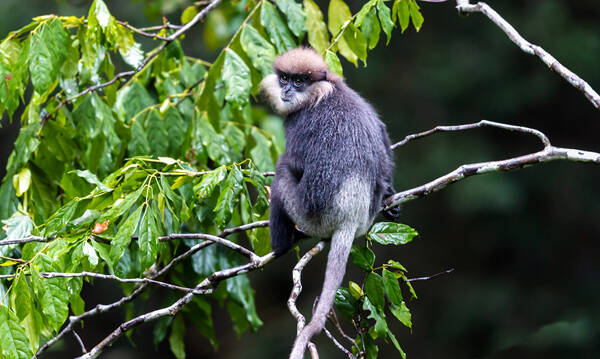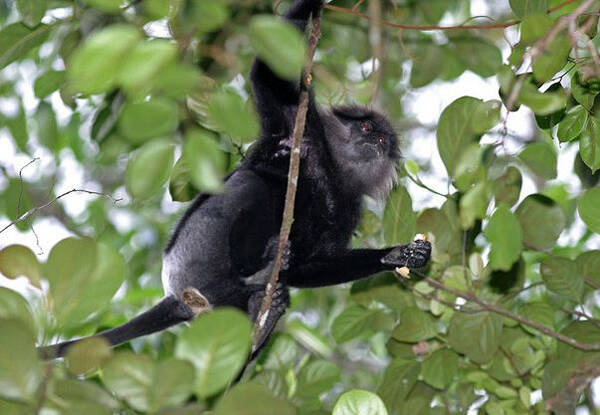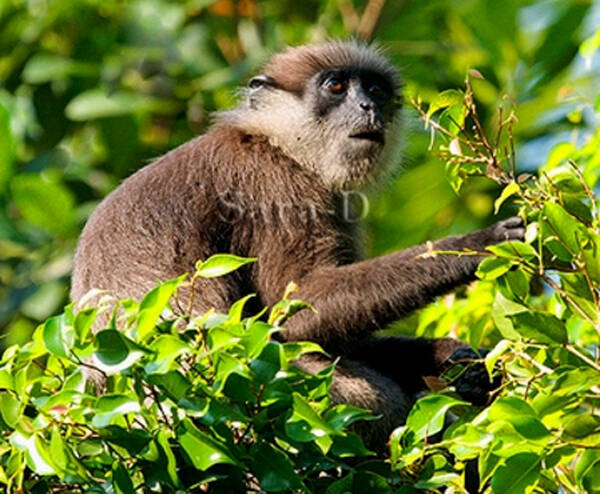Trachypithecus vetulus
IUCN
LCBasic Information
Scientific classification
- name:Trachypithecus vetulus
- Scientific Name:Trachypithecus vetulus,Purple-faced Langur
- Outline:Primates
- Family:Monkey genus
Vital signs
- length:44.7-67.3cm
- Weight:About 8.5kg
- lifetime:No verification information
Feature
Have a relatively short thumb
Distribution and Habitat
The purple-faced langur is found throughout Sri Lanka. This species lives in monsoon forests, mature secondary forests, semi-deciduous forests and undisturbed cloud forests.
Appearance
The head and body length of the purple-faced langur is 44.7-67.3 cm; the tail length is 58.9-85.1 cm; the average weight of an adult male is about 8.5 kg, while the average weight of a female is about 7.8 kg. The skin color of the body and limbs is brown-black. The whiskers are white to light brown in color and grow backwards. This species has a relatively short thumb. The skin color of the newborn is light gray with brown tints on the chest, arms and legs. The crown of the newborn is also pale gray with brown tints, but the occipital area is lighter. The naked parts of the newborn's body are pink.
This species has four subspecies, each with different fur coloration:
The overall coloration of the nominate subspecies is gray-black with lighter hair color. The waist and the top part of the tail are light brown with a cream color at the tip. The head and cheek whiskers are brown or gray-brown.
The fur color of the wetland subspecies (Trachypithecus vetulus nestor) is lighter
Details
Purple-faced Langur (Trachypithecus vetulus) has four subspecies.

Purple-faced Langurs form small groups ranging in size from 3 to 16. The average group size is 8.4, with 8-9 being the most common. This is a diurnal, wooded species that rarely moves on the ground and only stays on the ground for short periods of time. The range of all-male groups overlaps with the family ranges of different groups, but the ranges of different family groups rarely overlap.
The purple-faced langur has an unequal social system, with males having harems of up to seven females. The basic group consists of 1 resident adult male, 1-7 adult females, and some infants, and some family groups may have 2 adult males. All-male groups, ranging from 2 to 14, have their own territories. In all-male groups, there may also be subadult and adult females, and in all-male groups, females are found to be infertile as no infants or juveniles were found. All-male groups also disperse during the day and change sleeping locations. In all-male groups, membership tends to be flexible, and group membership changes regularly.

The purple-faced black-brown monkey moves through the forest four times faster than a macaque and twice as fast as a leaf monkey. This species can adjust its group sequence to form groups of 50 or more, and they are more adaptable to changes in the environment than ordinary leaf monkeys.
The purple-faced black-brown monkey is a leaf-eating species, but it also consumes fruits, flowers and seeds. Prefer immature young leaves, which are high in protein and low in lignin. The purple-faced langur's diet consists of 60% leaves, 12% flowers, and 28% fruits. Two-thirds of the leaves consumed are mature. Most of the leaves eaten come from twelve tree species, and they also like to eat fruits and dried fruits. During the winter monsoon season (February to March), the species consumes a large amount of young leaves and branches. From May to June, fruit consumption increases, as fruits are more abundant during this period, mainly from trees such as elm or other immature fruits. In July to September, which is mainly the dry season, a large amount of flowers will be consumed, mainly from heartwood (Haldina cordifolia). When the next monsoon arrives (October to November), the species will eat mature leaves, as well as young leaves and leaf buds. From December to January, leaves are an important part of the purple-faced langur's diet.
The gestation period of the purple-faced langur is 195-210 days, with one baby born per litter. The lactation period is 12-20 weeks, during which the baby becomes more independent from its mother, starts to eat solid food and participate in social activities. Weaning occurs between 7-8 months.

In Sri Lanka's mountains and the closed canopy forests in the southwest of the country, known as "wetlands". Only 19% of Sri Lanka consists of forested areas. This habitat fell from 80% in 1980 to about 25% in 2001. By 2010 this range had fallen to less than 3%. The range includes Sri Lanka's most densely populated lowland rainforest areas. Deforestation has resulted in the purple-faced langur's family range being exposed to direct sunlight. The purple-faced langur is most commonly found in small, widely dispersed groups. Ninety percent of its range is now made up of densely populated areas. Threats to this species include farmland, grazing, road construction, soil erosion and deforestation, prevention of poisoning caused by crop raiding, and the search for medicine and food.
Listed in the 2008 Red List of Threatened Species of the World Conservation Union (IUCN) ver 3.1 - Endangered (EN).
Listed in Appendix II of the Washington Convention on International Trade in Endangered Species (CITES).
Protect wild animals and stop eating game.
Maintaining ecological balance is everyone's responsibility!








